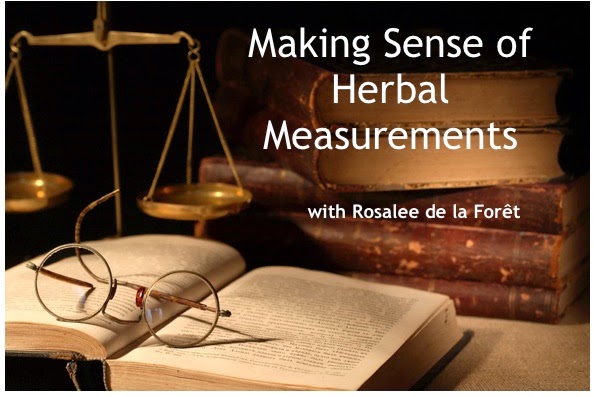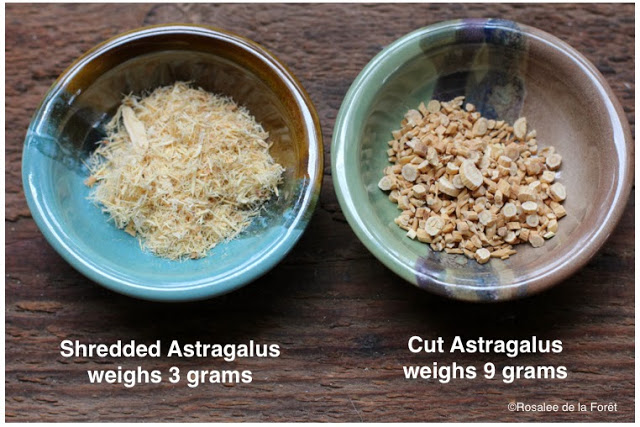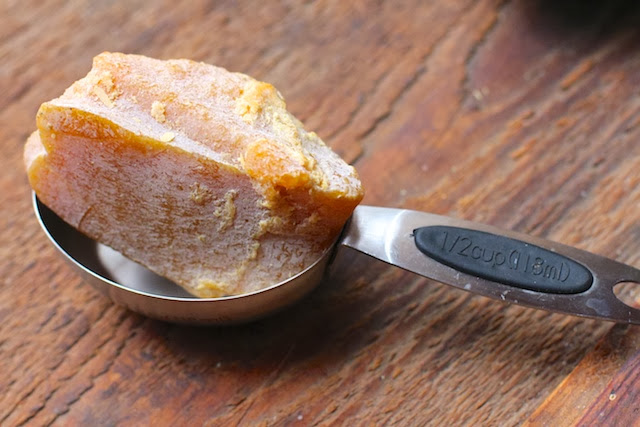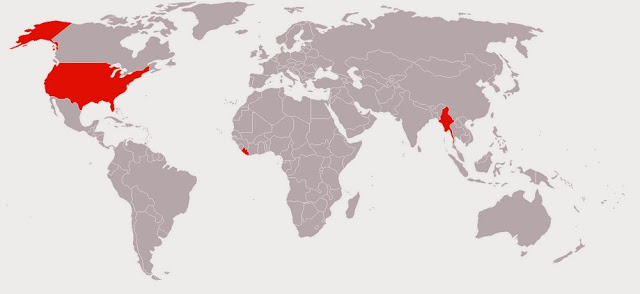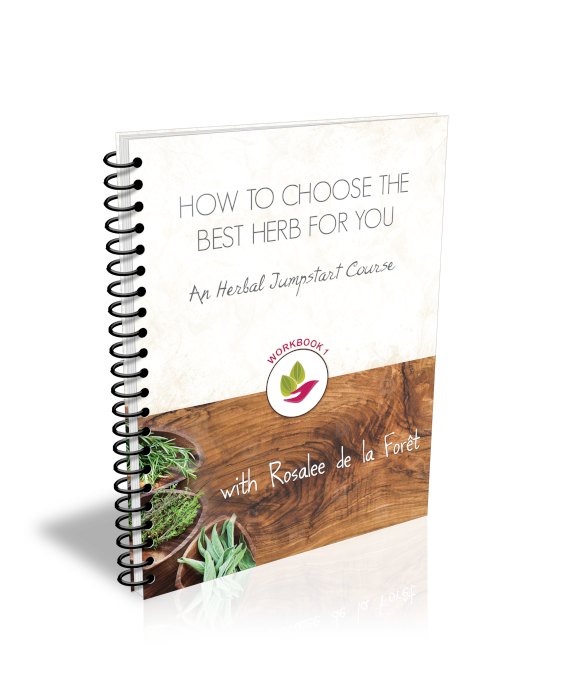Get weekly tips, recipes, and my Herbal Jumpstart e-course! Sign up for free today.

Making Sense of Herbal Measurements
Share this! |
|
There are so many facets to studying herbalism.
Besides learning about the herbs themselves we also study strange terminology like carminative and expectorant, and even energetic ways of understanding disease and tissue states such as dry/damp, hot/cold.
Then there is the art of medicine making, which is a whole other avenue of study.
This article is about navigating your way through understanding the different measurements commonly used in herbal medicine making.
Most people in the US are familiar with culinary or baking measurements such as 1/2 teaspoon of baking soda or 3/4 cup olive oil.
But in herbalism we use a variety of measurements that you may not be familiar with.
The good news is that, once they are explained and you have the right tools, they are really simple.
Weighing by Volume vs. Weight
Most culinary ingredients are measured by volume. In the US the Imperial System of measurement is commonly used. These are things like teaspoons, tablespoons, cups, etc.
Weighing by volume when things have a uniform shape is fairly accurate. For example, baking soda is pretty much the same consistency no matter where you buy it. So a teaspoon of baking soda in my kitchen is going to be the same as a teaspoon of baking soda in your kitchen.
But herbs, and other common ingredients in herbal recipes, do not always have a uniform shape.
If you and I both harvest and dry dandelion roots they may look very different. Maybe you cut yours up into super tiny fragments while I leave mine in larger chunks. This difference in size means that if we measured those by volume we could come up with two very different amounts.
In the photo below I measured out shredded astragalus and cut astragalus using the same sized spoon. You can see how big of a difference there is between the two.
Measuring oddly shaped things is just not accurate. This is why most things you buy in a box in the store state on the label something like, “Contents are measured by weight not volume.”
I have heard beginning herbalists complain that measuring things by weight is complicated. It may be different than what someone is used to, but it is often more simple than weighing by volume.
In order to accurately measure beeswax by volume, you would first have to melt the beeswax, pour the melted beeswax into a measuring cup, then clean off the melted beeswax from your measuring devices.
That is complicated.
In comparison, measuring beeswax by weight is very simple and much more accurate.
Common Sense Measurements
Granted, when making up your favorite pot of tea you don’t need to be precise in your measurements. A handful here and a pinch there can produce a delicious pot of tea. I'm certainly not advocating for precise measurements when you have a lot of experience and/or intuition on your side.
However, when you want to share those favorite recipes, measuring really helps! When I publish recipes I want the most accurate measurements possible so that people get a reliable result.
Can you imagine how bothersome it would be if I published a recipe that said, “throw a bit of kava in, followed by a bit more cocoa; once it seems done add a good amount of vanilla extract”?
The only thing I routinely measure by volume is liquids such as alcohol, tincture formulas, oils and aloe vera.
Everything else I weigh using this scale.
Imperial System vs. Metric System
If you grew up in the U.S. then you are probably most familiar with the Imperial Measurement System, which includes measurements like inches, ounces and pounds.
Only three countries in the entire world use the Imperial System of measurement (Myanmar, Liberia and the U.S.). The rest of the world uses the metric system.
Herbalist jim mcdonald likes to proudly stand in favor of the Imperial System, and maintains his positions with humorous remarks such as, “The metric system is the measuring system of the Borg.” If you are ever looking for cheap entertainment, strike up a pro-metric system conversation with jim. It’s pretty funny.
However, I often choose to use the metric system because I find it to be both simple and practical.
For example, the metric system is a lot easier to use when measuring small amounts of herbs.
I could measure out 3 grams of gentian root. Or I could measure out .106 ounces of it.
I also like the ability to easily communicate recipes with the rest of the world. I have many readers from the UK, Australia and India, where the metric system is used.
Perhaps jim is right and the metric system lacks poetry. There is something romantic about discussing weight in stones or distance in leagues.
But the metric system is super simple and practical, two things I favor.
How to Measure in Parts
Another strange measurement system you’ll see with herbal recipes is measuring things in parts.
Measuring in parts allows the user to determine how big or how little their batch is going to be.
When measuring in parts you simply choose the size you want your part to be.
Here’s an example of a chai recipe given in parts then converted to recipes by volume and by weight. There is a bit of a difference due to the limitations of volume measurements, but generally in tea blends like this precise accuracy is not needed.
In the large batch by volume my chosen part is a cup.
In the small batch by volume my chosen part is a tablespoon.
In the weight example my chosen part is 10 grams.

Herbalist 7Song has a pdf on using parts that goes into this a bit more deeply. You can see that here.
FAQs
How do I measure by weight if I don’t have a scale?
Unfortunately you can't. You’ll need to buy a scale. These are found fairly easily at cooking stores.
I bought this one on Amazon several years ago and I use it practically every day. It works great.
How do I convert ounces to grams (or vice versa)?
Many digital scales allow you to switch between grams/ounces. My scale does this with two pushes on a button.
There are also numerous online conversion tools. For example, if you go to a google search bar and type in “9 grams to ounces” it immediately converts it for you.

Summary
Whether you use the Imperial System, metric system, or the handful system, there is no one right way to measure. No matter what jim says about the metric system. :)
However, I hope this article helps you to understand different measurement systems and why an herbalist might choose one over the other.
If you have more questions about measuring please post them in the comments and I'll do my best to answer them.

Rosalee is an herbalist and author of the bestselling book Alchemy of Herbs: Transform Everyday Ingredients Into Foods & Remedies That Healand co-author of the bestselling book Wild Remedies: How to Forage Healing Foods and Craft Your Own Herbal Medicine. She's a registered herbalist with the American Herbalist Guild and has taught thousands of students through her online courses. Read about how Rosalee went from having a terminal illness to being a bestselling author in her full story here.
